Nitrogen vacancy centers in diamond are an exciting platform to build very accurate sensors. These vacancy centers provide very precise energy levels that can be influenced and controlled by various external factors such as pressure and magnetic fields. Moreover, diamond nanoparticles with nitrogen vacancy centers can be incorporated into tissues for biological sensing applications, as they show less toxicity.
Nitrogen vacancy centers (NV centers) can be used to detect very small magnetic fields in the order of nano to microteslas. Additionally, they provide better compact alternatives compared to other magnetic field sensors. The ability to manipulate the electron’s spin in these vacancy centers has been used to make diamond based spintronic devices. Another exciting application is the ability to make lasers in the microwave region, which are referred to as masers. This becomes possible as NV centers have energy gaps lying in the microwave region, making them suitable source for the active medium for masers.
In this blog post we will discuss the structure and energy levels in diamond NV centers, with their applications as magnetic field sensors and microwave lasers (masers).
Nitrogen Vacancy Centers in Diamond
Nitrogen vacancies in diamond can be formed by implanting nitrogen atoms in the diamond crystal and annealing the crystal. The position of the final nitrogen in the crystal is important to determine the energy levels. The NV lattice structure can easily be visualized from the following picture:

Diamond lattice with nitrogen vacancy.
As we can see, nitrogen has five valence electrons in its outer shell. Three of these electrons are used for bonding. Of the remaining, two non-bonding electrons, one occupies the vacancy center, and the other remains in the nitrogen atom. This configuration is referred to as the NV- state for the vacancy center. Depending on the spin orientation of the two non-bonding electrons in nitrogen, singlet or triplet states are observed.
Energy Levels of Nitrogen Vacancy Centers
Detailed calculations show two bands of energy levels at the nitrogen vacancy centers. These levels can be further split by a magnetic field to give smaller sub energy levels in each band. The image below shows the various bands along with levels that can be excited by infrared or visible light.
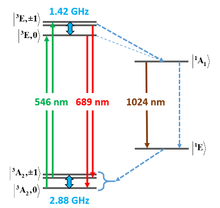
Energy levels in NV centers. Courtesy Wiki
Green and red lasers can be used for excitation across the gaps in the triplet states of the NV center. Infrared light at 1024 nm can be used to excite singlet states. The sub-gaps within each band are in the order of GHz which lies in the microwave region of the electromagnetic spectrum. Thus electrons in these levels can be excited by microwave radiation. Importantly, the lifetime of electrons in these energy levels can be a few seconds when operated at low temperatures.
Applications of Nitrogen Vacancy Centers
The use of nitrogen vacancy centers comes from its ability to maintain precise energy levels. The general principle by which various diamond based sensors are used, is by detecting the change in the energy levels by some external parameters. For example, these energy levels are split or shifted by magnetic field, electric field, or stress in the crystal. The external parameters can be measured with very good accuracy, because of the ability of NV centers to maintain sharp energy levels.
Magnetic Field Sensors using NV Centers
The pair of non-bonding electrons in nitrogen’s outer shell can exist in a triplet or singlet state. In the triplet state, splitting of the three degenerate levels occur when an external magnetic field is present. This is referred to as the Zeeman effect. Thanks to the Zeeman effect, if we excite the vacancy center by a laser, and observe the fluorescence spectrum of the emitted light, we will observe additional signals for energy levels for the +1 and -1 triplet states. This is shown as two separate lines in the image below. Conveniently, the spacing between these levels can be used to calculate the amount of external magnetic field present.
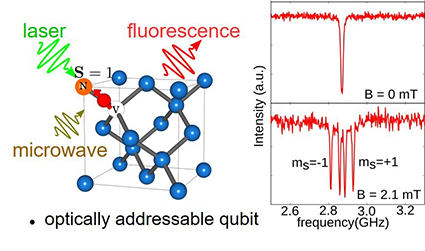
Zeeman splitting of energy levels in a magnetic field. Courtesy JAIST
To engineer NV centers into field sensors they can be integrated into fibers to make fiber based magnetic field sensors. To accomplish this diamond NV centers are introduced into the core of the fiber. A photonic crystal fiber cladding can also be used to reduce signal losses compared to non-structured fibers. The image below shows the diamond NV nanoparticles incorporated into the core of the fiber. The cladding is a hexagonal photonic crystal observed as an array of small white dots in the image.
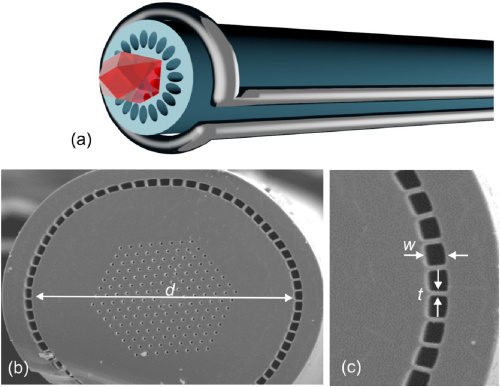
Photonic crystal fibers with NV centers for magnetic field sensing. Courtesy OSA
One of the vivid applications of this technology is the detection of low intensity magnetic field from neurons. The setup below shows how a NV center can be used to detect magnetic field from a neuron sample mounted on a diamond substrate. Astoundingly, magnetic field in the order of nanoteslas can be detected in this fashion.
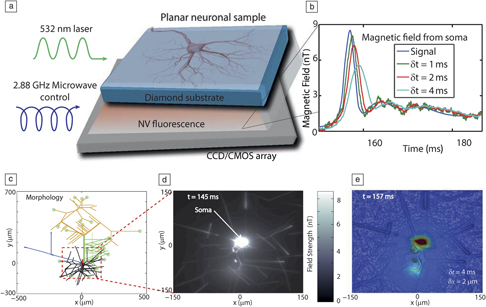
NV centers for sensing magnetic field from neurons. Courtesy ResearchGate
Masers
Lasers are operated usually from the UV spectrum into the infrared spectrum. But can lasers go farther down in the electromagnetic spectrum? This is indeed possible, and lasers in the microwave spectrum have previously been designed and demonstrated. As usual, a gain medium and a resonator are required for lasing to occur. An energy gap in the order of GHz is required, which lies in the microwave region. Diamond NV centers contain energy gaps in the microwave region which can be controlled for lasing. The setup for a maser is shown below. Here the diamond NV centers act as the gain medium embedded in a cylindrical cavity resonator.
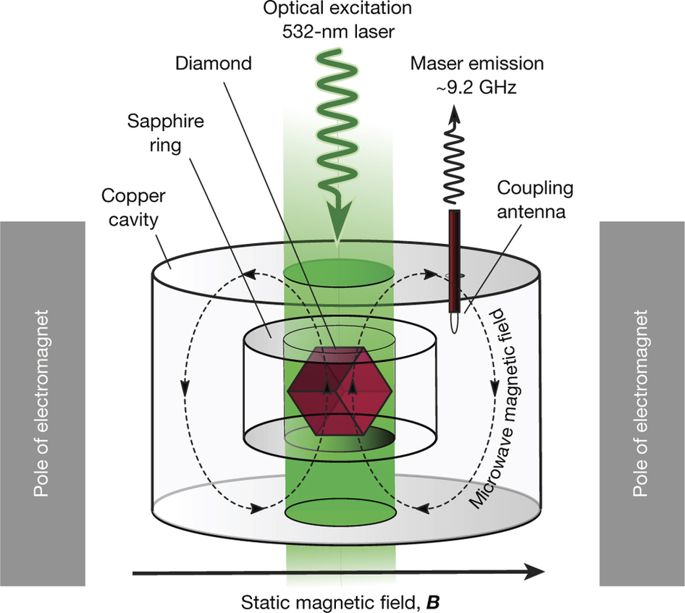
Microwave laser using diamond NV centers. Courtesy Nature
The gain medium is excited using green light, while the output is extracted by a coupling antenna embedded in the cavity resonator. The whole setup can operate at room temperature with a wide range of wavelengths possible by modulating the diamond crystal’s energy levels. They can be used as an alternative source of microwave energy compared to a magnetron gun.
Conclusion
As we explored in this blog post, NV centers represent an exciting approach to field sensing and maser design applications. We will conclude here, simply adding that the diamond nanoparticles with NV centers can be embedded within biomolecules to make novel biomedical sensors. The low-toxicity of diamond makes this an exciting new avenue for research – perhaps a topic for our upcoming blog posts.
What are some of the other applications that you have heard of? Would you like to hear more about this topic? We would like to hear your comments.
Did you know, FindLight marketplace offers a wide variety of fiber optic sensors, red laser diodes, and spectrum analyzers to use in your designs and experiments.
